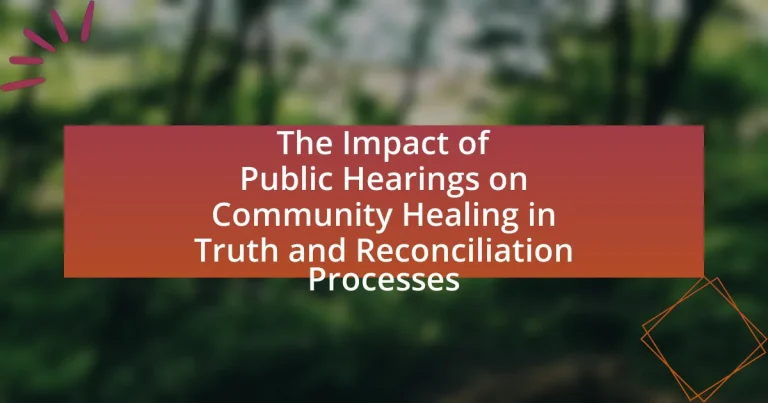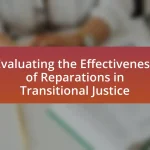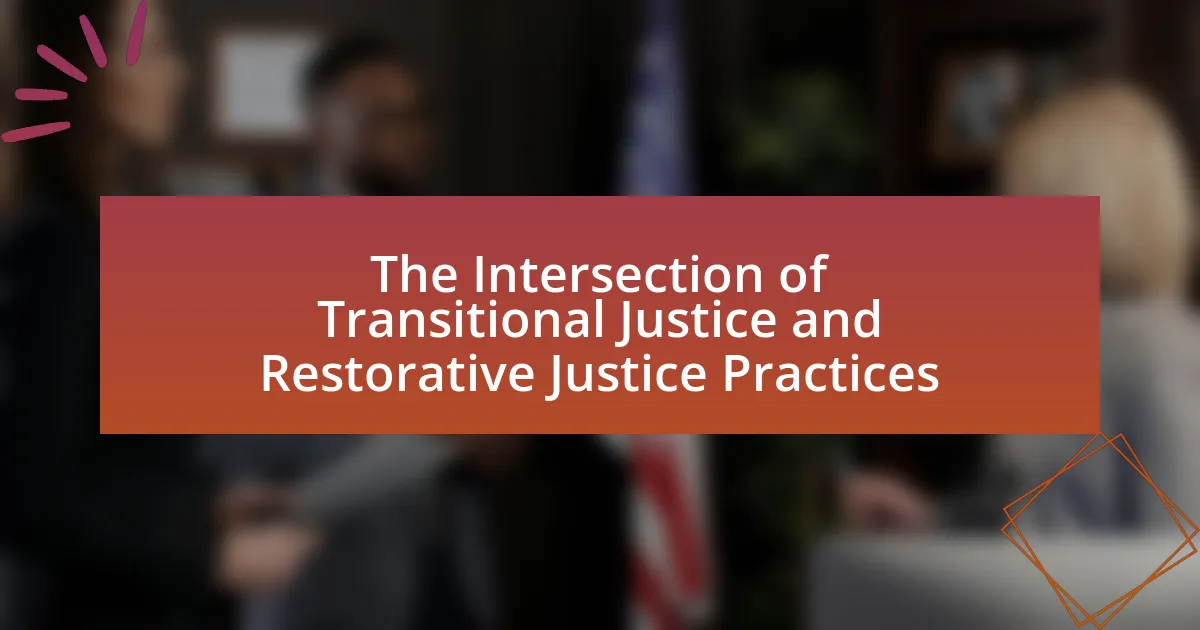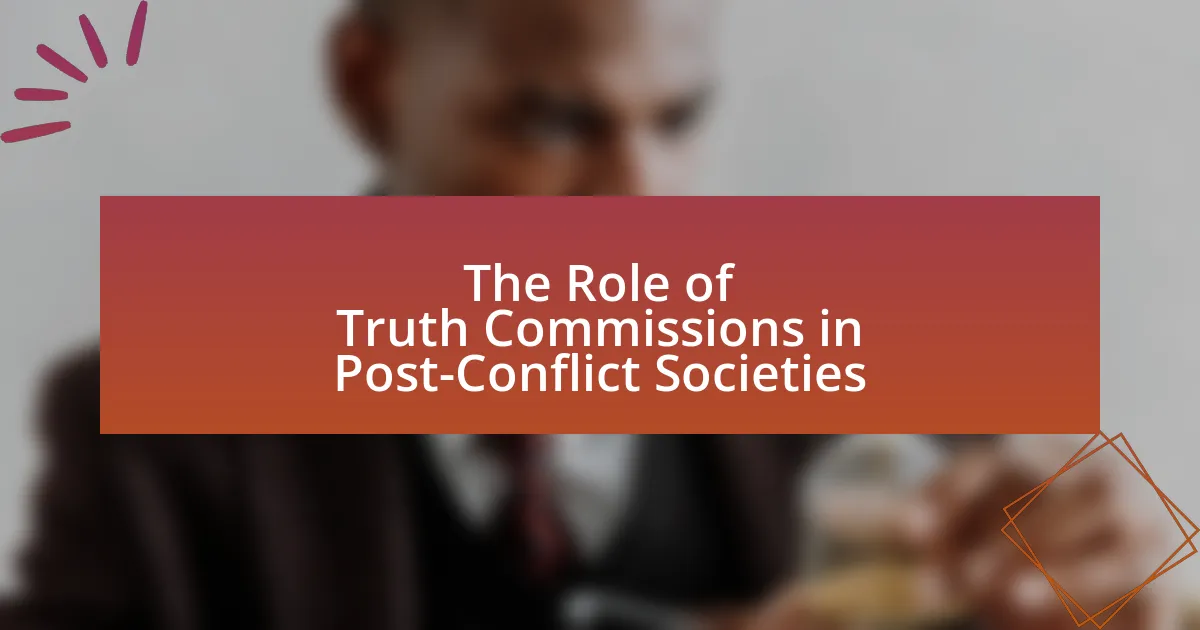Public hearings play a crucial role in community healing during truth and reconciliation processes by providing a platform for victims to share their experiences and fostering collective dialogue. These hearings facilitate acknowledgment of past injustices, promote emotional healing, and help rebuild trust within communities. Research highlights that public hearings can lead to increased awareness of historical grievances, validate marginalized voices, and contribute to policy changes that reflect community needs. Additionally, they face challenges such as mistrust and barriers to participation, which can hinder their effectiveness in promoting genuine dialogue and reconciliation. Overall, public hearings are essential for addressing historical injustices and fostering resilience within communities.

What is the Impact of Public Hearings on Community Healing in Truth and Reconciliation Processes?
Public hearings significantly contribute to community healing in truth and reconciliation processes by providing a platform for victims to share their experiences and for communities to engage in collective dialogue. This engagement fosters acknowledgment of past injustices, which is essential for emotional healing and rebuilding trust within the community. Research indicates that public hearings can lead to increased awareness and understanding of historical grievances, as seen in the South African Truth and Reconciliation Commission, where testimonies helped to validate the experiences of victims and promote societal healing. Furthermore, these hearings often facilitate a sense of closure for individuals and communities, enabling them to move forward and work towards reconciliation.
How do public hearings facilitate community healing?
Public hearings facilitate community healing by providing a structured platform for individuals to voice their experiences and grievances, fostering dialogue and understanding among community members. This process allows for the acknowledgment of past injustices, which is essential for emotional and psychological healing. Research indicates that public hearings can lead to increased trust in institutions and promote collective healing by validating the experiences of marginalized groups. For example, the Truth and Reconciliation Commission in Canada utilized public hearings to address the historical trauma of Indigenous peoples, resulting in a documented increase in community engagement and a pathway toward reconciliation.
What are the psychological effects of public hearings on individuals?
Public hearings can significantly impact individuals psychologically by fostering a sense of empowerment and community engagement. These events often provide a platform for individuals to voice their experiences and grievances, which can lead to catharsis and validation of their feelings. Research indicates that participation in public hearings can enhance individuals’ sense of agency, as they feel their contributions may influence decision-making processes. Additionally, public hearings can facilitate collective healing by promoting social cohesion and shared understanding among community members. Studies, such as those conducted by the Truth and Reconciliation Commission, have shown that when individuals share their stories in a supportive environment, it can lead to reduced feelings of isolation and increased emotional resilience.
How do public hearings promote collective memory and acknowledgment?
Public hearings promote collective memory and acknowledgment by providing a platform for individuals and communities to share their experiences and narratives related to historical injustices. This process facilitates the documentation of personal testimonies, which are essential for creating a shared understanding of past events. For instance, in truth and reconciliation commissions, public hearings have been instrumental in revealing the extent of human rights violations, as seen in the South African Truth and Reconciliation Commission, where over 21,000 statements were collected, contributing to a national narrative of apartheid’s impact. By fostering dialogue and validating individual experiences, public hearings help communities collectively remember their history and acknowledge the suffering endured, thereby supporting healing and reconciliation efforts.
Why are public hearings essential in truth and reconciliation processes?
Public hearings are essential in truth and reconciliation processes because they provide a platform for victims and communities to share their experiences and grievances publicly. This sharing fosters acknowledgment of past injustices, which is crucial for healing and rebuilding trust within affected communities. Historical examples, such as the South African Truth and Reconciliation Commission, demonstrate that public testimonies can validate the experiences of marginalized groups, promote collective memory, and facilitate dialogue among diverse stakeholders. By allowing for transparency and accountability, public hearings contribute significantly to the overall effectiveness of reconciliation efforts.
What role do public hearings play in addressing historical injustices?
Public hearings serve as a vital mechanism for addressing historical injustices by providing a platform for marginalized voices to be heard and acknowledged. These hearings facilitate the documentation of personal testimonies and experiences related to injustices, which can validate the suffering of affected communities and contribute to collective memory. For instance, the Truth and Reconciliation Commission in South Africa utilized public hearings to uncover the atrocities of apartheid, allowing victims to share their stories, which played a crucial role in national healing and reconciliation efforts. By fostering dialogue and transparency, public hearings help to promote accountability and encourage societal reflection on past wrongs, ultimately aiding in the restoration of trust within communities.
How do public hearings contribute to building trust within communities?
Public hearings contribute to building trust within communities by providing a platform for open dialogue and transparency between community members and decision-makers. This process allows individuals to voice their concerns, share experiences, and participate in discussions that affect their lives, fostering a sense of inclusion and ownership. Research indicates that when communities engage in public hearings, they report higher levels of trust in local government and institutions, as these hearings demonstrate accountability and responsiveness to community needs. For example, a study by the International Association for Public Participation found that communities involved in participatory processes, such as public hearings, experienced a 30% increase in trust towards local authorities. This evidence underscores the role of public hearings in enhancing community cohesion and trust.
What challenges do public hearings face in promoting community healing?
Public hearings face significant challenges in promoting community healing, primarily due to issues of mistrust and lack of representation. Mistrust arises when community members feel that their voices are not genuinely heard or valued, often stemming from historical injustices or previous negative experiences with governmental processes. Additionally, lack of representation can occur when the demographics of participants do not reflect the broader community, leading to feelings of alienation among marginalized groups. Research indicates that these factors can hinder the effectiveness of public hearings in fostering genuine dialogue and reconciliation, ultimately limiting their potential to facilitate healing within the community.
What are the barriers to participation in public hearings?
Barriers to participation in public hearings include lack of awareness, accessibility issues, and intimidation factors. Many community members may not be informed about the hearings due to insufficient outreach or communication efforts, which can limit their ability to engage. Accessibility issues, such as transportation challenges or physical barriers to venues, further hinder participation. Additionally, intimidation factors, including fear of judgment or feeling unqualified to speak, can discourage individuals from voicing their opinions. Research indicates that these barriers significantly impact community engagement in reconciliation processes, as highlighted in studies on civic participation and public discourse.
How can the effectiveness of public hearings be measured?
The effectiveness of public hearings can be measured through participant engagement, feedback quality, and the influence on policy decisions. Participant engagement can be assessed by attendance numbers, demographic diversity, and the level of interaction during the hearings. Feedback quality can be evaluated through surveys that gauge participant satisfaction and perceived impact on community issues. Additionally, the influence on policy decisions can be tracked by analyzing changes in legislation or community initiatives that arise directly from the hearings. For instance, a study by the National Civic League found that communities with higher engagement in public hearings saw a 30% increase in policy changes reflecting community input, demonstrating a clear link between effective public hearings and tangible outcomes.
How do public hearings connect to broader reconciliation efforts?
Public hearings serve as a vital mechanism in broader reconciliation efforts by facilitating open dialogue and allowing marginalized voices to be heard. These hearings create a platform for individuals and communities affected by historical injustices to share their experiences, fostering understanding and empathy among different societal groups. For instance, in the context of the Truth and Reconciliation Commission in Canada, public hearings provided survivors of residential schools an opportunity to recount their stories, which contributed to a national acknowledgment of past wrongs and the need for reparative actions. This process not only aids in healing for individuals but also promotes collective accountability and encourages societal transformation towards justice and equity.
What lessons can be learned from past public hearings in reconciliation processes?
Past public hearings in reconciliation processes demonstrate the importance of inclusivity and transparency in fostering community healing. These hearings often reveal the need for diverse voices to be heard, as seen in the Truth and Reconciliation Commission of Canada, which highlighted the experiences of Indigenous peoples. Additionally, they underscore the significance of creating safe spaces for testimony, allowing individuals to share their stories without fear of retribution, which has been shown to facilitate emotional healing and collective understanding. Furthermore, the effectiveness of follow-up actions based on the hearings’ findings is crucial; for instance, the South African Truth and Reconciliation Commission’s recommendations led to policy changes that aimed to address systemic injustices. These lessons indicate that successful reconciliation requires active engagement, acknowledgment of past harms, and a commitment to ongoing dialogue and action.

What specific outcomes result from public hearings in community healing?
Public hearings in community healing lead to increased community engagement, enhanced trust among stakeholders, and the identification of collective grievances. These outcomes are crucial in fostering a sense of belonging and shared responsibility within the community. Research indicates that public hearings facilitate open dialogue, allowing participants to express their experiences and emotions, which is essential for healing. For instance, a study by the Truth and Reconciliation Commission of Canada found that public testimonies during hearings helped survivors articulate their pain, contributing to both individual and communal healing processes. This demonstrates that public hearings serve as a vital mechanism for addressing historical injustices and promoting reconciliation.
How do public hearings influence policy changes?
Public hearings influence policy changes by providing a platform for community members to voice their opinions and concerns, which policymakers can then consider in their decision-making processes. This engagement fosters transparency and accountability, allowing citizens to participate actively in governance. For instance, a study by the National Civic League found that public hearings can lead to more informed policy decisions, as they incorporate diverse perspectives and local knowledge, ultimately resulting in policies that better reflect community needs.
What types of policies are often influenced by public hearings?
Public hearings often influence policies related to community development, environmental regulations, and social justice initiatives. These hearings provide a platform for stakeholders to voice their opinions, which can lead to adjustments in proposed legislation or regulations. For instance, in the context of environmental policies, public hearings allow community members to express concerns about local projects, resulting in modifications to ensure better environmental protection. Similarly, social justice policies can be shaped by public input during hearings, reflecting the community’s needs and values in legislative decisions.
How do these policy changes affect community dynamics?
Policy changes related to public hearings in truth and reconciliation processes enhance community dynamics by fostering open dialogue and collective healing. These changes encourage participation from diverse community members, allowing for shared narratives that promote understanding and empathy. Research indicates that inclusive public hearings can lead to increased trust among community members, as evidenced by the findings of the Truth and Reconciliation Commission of Canada, which reported that communities engaged in these processes experienced improved relationships and social cohesion.
What are the long-term effects of public hearings on communities?
Public hearings have significant long-term effects on communities, primarily fostering increased civic engagement and promoting social cohesion. These forums allow community members to voice their concerns and experiences, which can lead to a greater sense of ownership and responsibility towards local governance. Research indicates that communities that participate in public hearings often experience enhanced trust in public institutions, as transparency and accountability are prioritized. For instance, a study by the National Civic League found that communities engaged in regular public hearings reported a 30% increase in citizen participation in local decision-making processes over five years. Additionally, public hearings can facilitate healing and reconciliation by providing a platform for marginalized voices, ultimately contributing to a more inclusive community narrative.
How do public hearings impact intergenerational relationships?
Public hearings significantly impact intergenerational relationships by fostering dialogue and understanding among different age groups. These forums allow younger and older generations to share their perspectives on community issues, thereby bridging gaps in communication and fostering empathy. Research indicates that when communities engage in public hearings, they create opportunities for storytelling and sharing experiences, which can strengthen familial and community bonds. For instance, studies have shown that intergenerational dialogue during public hearings can lead to increased trust and collaboration, as participants recognize shared values and concerns. This collaborative environment promotes healing and reconciliation, essential for addressing historical grievances and building a cohesive community.
What role do public hearings play in fostering resilience in communities?
Public hearings play a crucial role in fostering resilience in communities by providing a platform for open dialogue and collective decision-making. This participatory process allows community members to voice their concerns, share experiences, and contribute to solutions, thereby strengthening social cohesion. Research indicates that communities engaged in public hearings demonstrate increased trust in local governance and enhanced community ties, which are essential for resilience. For example, a study by the National Civic League found that communities that actively participate in public hearings report higher levels of civic engagement and improved community well-being, reinforcing the idea that inclusive dialogue is vital for building resilient communities.
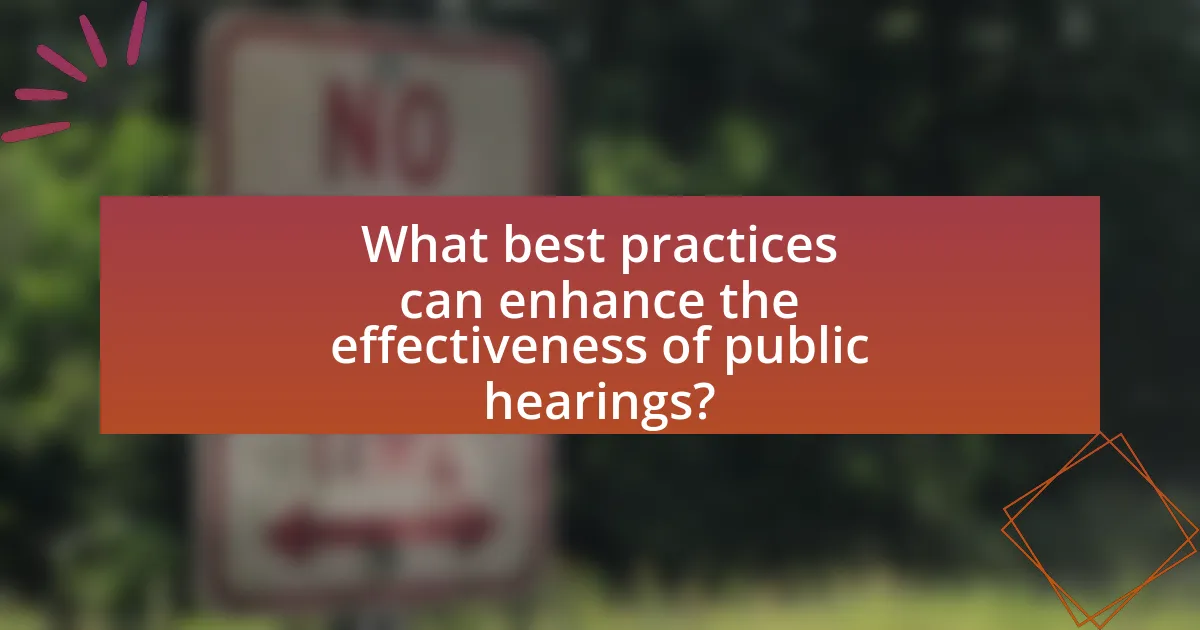
What best practices can enhance the effectiveness of public hearings?
To enhance the effectiveness of public hearings, it is essential to ensure transparency, inclusivity, and structured facilitation. Transparency involves providing clear information about the purpose, process, and outcomes of the hearings, which fosters trust among participants. Inclusivity can be achieved by actively engaging diverse community members, ensuring that marginalized voices are heard, and accommodating different communication styles. Structured facilitation helps maintain focus and encourages respectful dialogue, allowing for a productive exchange of ideas. Research indicates that these practices lead to more meaningful participation and better outcomes in community healing processes, as seen in various truth and reconciliation initiatives globally.
How can facilitators improve the public hearing process?
Facilitators can improve the public hearing process by implementing structured agendas that prioritize participant engagement and ensure equitable speaking opportunities. This approach fosters a more inclusive environment, allowing diverse voices to be heard, which is essential for community healing in truth and reconciliation processes. Research indicates that structured formats can enhance clarity and focus, leading to more productive discussions and outcomes. For instance, a study by the National Coalition for Dialogue & Deliberation highlights that well-facilitated public hearings can increase participant satisfaction and trust in the process, ultimately contributing to more effective reconciliation efforts.
What strategies can be employed to ensure inclusive participation?
To ensure inclusive participation in public hearings related to truth and reconciliation processes, strategies such as outreach, accessibility, and diverse representation must be employed. Outreach efforts should target marginalized communities through tailored communication methods, ensuring that information reaches those who may not typically engage in such processes. Accessibility involves providing resources such as translation services, transportation assistance, and venues that accommodate individuals with disabilities, thereby removing barriers to participation. Additionally, diverse representation can be achieved by actively involving various community stakeholders, including indigenous groups, youth, and other underrepresented populations, which fosters a more comprehensive dialogue and enhances the legitimacy of the reconciliation process. These strategies are supported by research indicating that inclusive participation leads to more effective and meaningful outcomes in community healing initiatives.
How can feedback mechanisms be integrated into public hearings?
Feedback mechanisms can be integrated into public hearings by utilizing structured surveys, real-time polling, and follow-up discussions to gather participant input. These methods allow attendees to express their views and concerns during and after the hearings, ensuring that their feedback is captured and considered in decision-making processes. For instance, implementing digital platforms for anonymous feedback can enhance participation and provide a safe space for individuals to share their thoughts, which is crucial in truth and reconciliation contexts where sensitive issues are discussed. Research indicates that incorporating such mechanisms can lead to increased community trust and engagement, as evidenced by case studies in various reconciliation initiatives that highlight improved outcomes when public input is actively solicited and addressed.
What resources are available for communities planning public hearings?
Communities planning public hearings can access various resources, including guidelines from governmental agencies, templates for public hearing notices, and training materials on effective facilitation. The U.S. Environmental Protection Agency (EPA) provides a Public Participation Guide that outlines best practices for engaging communities in public hearings. Additionally, organizations like the International Association for Public Participation offer resources and training on public engagement strategies. These resources are designed to enhance community involvement and ensure that public hearings are conducted effectively, fostering transparency and inclusivity in the decision-making process.
How can communities effectively prepare for public hearings?
Communities can effectively prepare for public hearings by organizing informational sessions to educate residents about the hearing’s purpose and process. These sessions should include discussions on the specific issues at hand, the importance of community participation, and the potential impact of the hearings on local policies. Engaging local leaders and stakeholders to facilitate these sessions can enhance understanding and encourage broader participation. Additionally, communities should gather and synthesize relevant data and testimonies to present a well-rounded perspective during the hearings. Research indicates that informed participation leads to more constructive dialogue and better outcomes in public hearings, as seen in various case studies on community engagement in policy-making.
